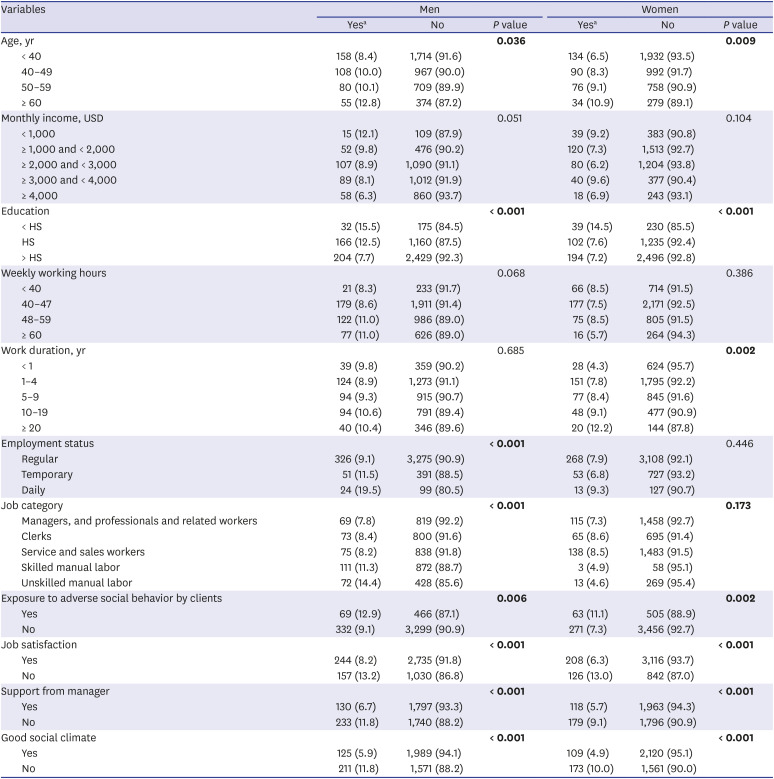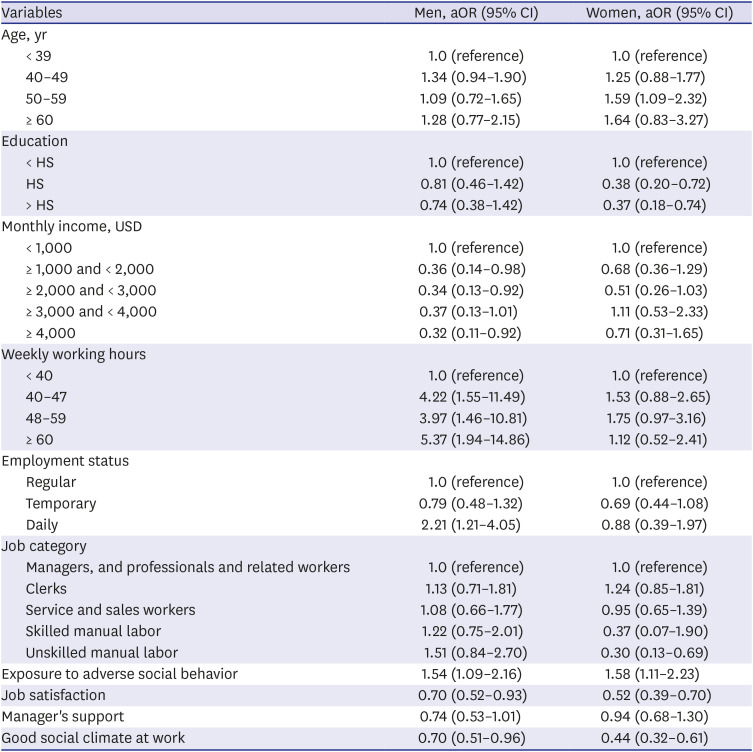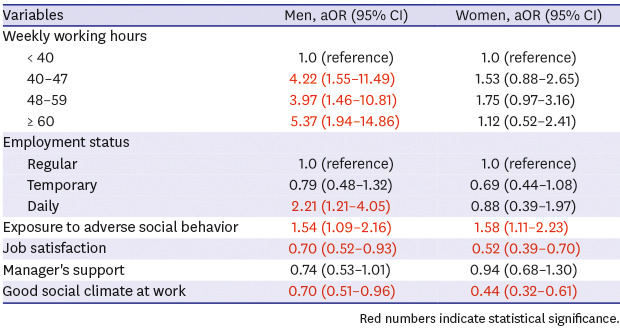1. Hochschild AR. The Managed Heart: Commercialization of Human Feeling. Berkeley, CA: University of California Press;1991.
2. de Castro AB, Agnew J, Fitzgerald ST. Emotional labor: relevant theory for occupational health practice in post-industrial America. AAOHN J. 2004; 52(3):109–115. PMID:
15068101.
3. Eurofound. Sixth European Working Conditions Survey–Overview Report (2017 update). Luxembourg: Publications Office of the European Union;2017.
4. Korea Occupational Safety and Health Agency. The Fifth Korean Working Conditions Survey. Ulsan: Korea Occupational Safety and Health Agency;2019.
5. Kim YS, Rhee KY, Oh MJ, Park J. The validity and reliability of the second Korean working conditions survey. Saf Health Work. 2013; 4(2):111–116. PMID:
23961335.

6. Statistics Korea. Korean Standard Classification of Occupations. Daejeon: Statistics Korea;2016.
7. International Labour Office. International Standard Classification of Occupations: ISCO-88. Geneva: International Labour Office;2012.
8. World Health Organization. WHO (Five) Well-Being Index. Geneva: World Health Organization;1998.
9. Park J, Han BY, Kim Y. Gender differences in occupations and complaints of musculoskeletal symptoms: representative sample of South Korean workers. Am J Ind Med. 2017; 60(4):342–349. PMID:
28262963.

10. Kelly MM, Tyrka AR, Price LH, Carpenter LL. Sex differences in the use of coping strategies: predictors of anxiety and depressive symptoms. Depress Anxiety. 2008; 25(10):839–846. PMID:
17603810.

11. Virtanen M, Ferrie JE, Singh-Manoux A, Shipley MJ, Stansfeld SA, Marmot MG, et al. Long working hours and symptoms of anxiety and depression: a 5-year follow-up of the Whitehall II study. Psychol Med. 2011; 41(12):2485–2494. PMID:
21329557.

12. Virtanen M, Stansfeld SA, Fuhrer R, Ferrie JE, Kivimäki M. Overtime work as a predictor of major depressive episode: a 5-year follow-up of the Whitehall II study. PLoS One. 2012; 7(1):e30719. PMID:
22295106.

13. Yoon Y, Ryu J, Kim H, Kang CW, Jung-Choi K. Working hours and depressive symptoms: the role of job stress factors. Ann Occup Environ Med. 2018; 30(1):46. PMID:
30009036.

14. Park J, Han B, Park JS, Park EJ, Kim Y. Nonstandard workers and differential occupational safety and health vulnerabilities. Am J Ind Med. 2019; 62(8):701–715. PMID:
31218723.

15. Park J, Han B, Kim Y. Association of job satisfaction and security with subjective health and well-being in Korean employees. J Occup Environ Med. 2018; 60(10):e525–32. PMID:
30095588.

16. Jang SY, Jang SI, Bae HC, Shin J, Park EC. Precarious employment and new-onset severe depressive symptoms: a population-based prospective study in South Korea. Scand J Work Environ Health. 2015; 41(4):329–337. PMID:
25909824.

17. Kim IH, Muntaner C, Khang YH, Paek D, Cho SI. The relationship between nonstandard working and mental health in a representative sample of the South Korean population. Soc Sci Med. 2006; 63(3):566–574. PMID:
16580108.

18. Son MG. Women's dual burden and the characteristics of their paid work time: Focusing on dual earner couples. Korea Journal of Population Studies. 2005; 28(1):277–311.
19. Choi SY, Chang KS. The material contradictions of proletarian patriarchy under condensed capitalist industrialization: The instability in the working life courses of “male breadwinners” and its familial ramifications. Korean J Sociol. 2012; 46(2):203–230.
20. Quinlan M. The Effects of Non-standard Forms of Employment on Worker Health and Safety. Geneva: International Labour Office;2015.
21. Park J, Han B, Park JS, Park EJ, Kim Y. Nonstandard workers and differential occupational safety and health vulnerabilities. Am J Ind Med. 2019; 62(8):701–715. PMID:
31218723.

22. Schütte S, Chastang JF, Parent-Thirion A, Vermeylen G, Niedhammer I. Social inequalities in psychological well-being: a European comparison. Community Ment Health J. 2014; 50(8):987–990. PMID:
24664367.

23. Faragher EB, Cass M, Cooper CL. The relationship between job satisfaction and health: a meta-analysis. Occup Environ Med. 2005; 62(2):105–112. PMID:
15657192.

24. Hogh A, Henriksson ME, Burr H. A 5-year follow-up study of aggression at work and psychological health. Int J Behav Med. 2005; 12(4):256–265. PMID:
16262544.

25. Willness CR, Steel P, Lee K. A meta-analysis of the antecedents and consequences of workplace sexual harassment. Person Psychol. 2007; 60(1):127–162.

26. Bonafons C, Jehel L, Coroller-Béquet A. Specificity of the links between workplace harassment and PTSD: primary results using court decisions, a pilot study in France. Int Arch Occup Environ Health. 2009; 82(5):663–668. PMID:
18953560.

27. Min KB, Park SG, Hwang SH, Min JY. Precarious employment and the risk of suicidal ideation and suicide attempts. Prev Med. 2015; 71:72–76. PMID:
25532676.

28. Robbins JM, Ford MT, Tetrick LE. Perceived unfairness and employee health: a meta-analytic integration. J Appl Psychol. 2012; 97(2):235–272. PMID:
21928872.

29. Ferrie JE, Head J, Shipley MJ, Vahtera J, Marmot MG, Kivimäki M. Injustice at work and incidence of psychiatric morbidity: the Whitehall II study. Occup Environ Med. 2006; 63(7):443–450. PMID:
16698805.
30. Ndjaboué R, Brisson C, Vézina M. Organisational justice and mental health: a systematic review of prospective studies. Occup Environ Med. 2012; 69(10):694–700. PMID:
22693265.
31. Ogińska-Bulik N. Emotional intelligence in the workplace: exploring its effects on occupational stress and health outcomes in human service workers. Int J Occup Med Environ Health. 2005; 18(2):167–175. PMID:
16201208.
32. Holman D, Chissick C, Totterdell P. The effects of performance monitoring on emotional labor and well-being in call centers. Motiv Emot. 2002; 26(1):57–81.
33. Chang SJ, Koh SB, Kang D, Kim SA, Kang MG, Lee CG, et al. Developing an occupational stress scale for Korean employees. Korean J Occup Environ Med. 2005; 17(4):297–317.

34. Cropanzano R, Wright T. When a “happy” worker is really a “productive” worker: a review and further refinement of the happy-productive worker thesis. Consult Psychol J Pract Res. 2001; 53(3):182–199.

35. Diener E. Subjective well-being. The science of happiness and a proposal for a national index. Am Psychol. 2000; 55(1):34–43. PMID:
11392863.

36. Wright BA, Lopez S. Widening the diagnostic focus: a case for including human strengths and environmental resources. In : Snyder CR, Lopez SJ, editors. Handbook of Positive Psychology. Oxford: Oxford University Press;2002. p. 26–44.
37. Diener E, Larsen RJ. The experience of emotional well-being. In : Lewis M, Haviland JM, editors. Handbook of Emotions. New York, NY: Guilford;1993. p. 405–415.
38. Topp CW, Østergaard SD, Søndergaard S, Bech P. The WHO-5 well-being index: a systematic review of the literature. Psychother Psychosom. 2015; 84(3):167–176. PMID:
25831962.








 PDF
PDF Citation
Citation Print
Print




 XML Download
XML Download